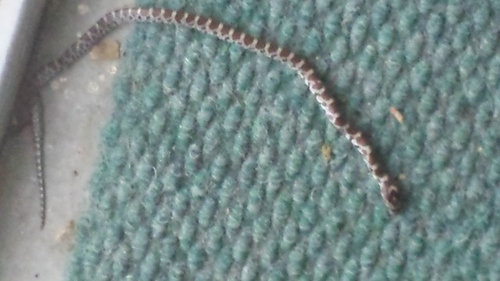snake id??
wolfe0311
10 years ago
Related Stories

DENS AND LIBRARIESRoom of the Day: Princess the Snake Reigns in a Luxe Library
Sure, there are books. But in this library the custom snake habitat may be most worth checking out
Full Story
UPHOLSTERYThe Perks and Perils of Reupholstering Old Furniture
Secondhand upholstered pieces can add character to a room, but beware of bugs, snakes and hidden costs
Full Story
LANDSCAPE DESIGNStars and Myths Inspire a Contemporary London Garden
A sinuously snaking path, tiles like dragon skin and a triad of stone apples give a British garden an air of enchantment
Full Story
LANDSCAPE DESIGNGardening for Happy Kids
Foster creativity, self-esteem and more by designing your landscape with a sense of discovery
Full Story
BEDROOMSDream Spaces: Bedrooms With Amazing Views
Soaring over the city or nestled amidst nature, these sleeping spaces focus on the most divinely designed feature of all
Full Story
LANDSCAPE DESIGNMysticism and Meaning Meet in an Ohio Artist’s Gardens
Step into landscape scenes rife with symbolism, inspired by math, philosophy and the stars
Full Story
FEEL-GOOD HOMEStop That Draft: 8 Ways to Keep Winter Chills Out
Stay warm without turning up the thermostat by choosing the right curtains, windows and more
Full Story
PRODUCT PICKSGuest Picks: 20 Ways With Agate
The stone is fabled to have powerful healing properties, but it's a fact that it can beautify a home
Full Story
HOUZZ TOURSMy Houzz: An Oregon Cottage With 21 Flavors of Color
A profusion of paint colors plus inviting porches and gathered pieces create a welcoming feel in a retired couple's 100-year-old home
Full Story
GARDENING FOR BUTTERFLIES3 Ways Native Plants Make Gardening So Much Better
You probably know about the lower maintenance. But native plants' other benefits go far beyond a little less watering and weeding
Full StorySponsored







Smivies (Ontario - 5b)
wolfe0311Original Author
Related Professionals
Arlington Landscape Architects & Landscape Designers · Billerica Landscape Contractors · Norwood Landscape Contractors · Addison Landscape Contractors · Davis Landscape Contractors · Dickinson Landscape Contractors · Flagstaff Landscape Contractors · Kettering Landscape Contractors · Longview Landscape Contractors · Maywood Landscape Contractors · Mount Sinai Landscape Contractors · North Potomac Landscape Contractors · Rio Linda Landscape Contractors · Vacaville Landscape Contractors · Summerlin South Swimming Pool Buildersdog_wood_2010
Smivies (Ontario - 5b)
dog_wood_2010
SouthCountryGuy Zone 4b-5 SE BC
dog_wood_2010
SouthCountryGuy Zone 4b-5 SE BC
dog_wood_2010
SouthCountryGuy Zone 4b-5 SE BC
Smivies (Ontario - 5b)
dog_wood_2010
SouthCountryGuy Zone 4b-5 SE BC
dog_wood_2010
SouthCountryGuy Zone 4b-5 SE BC
dog_wood_2010
weezy2482